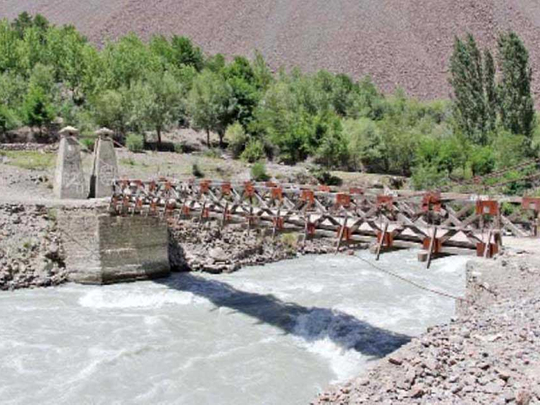
Islamabad: A suspension bridge built by the British rulers on Laspur river connecting two villages in Chitral district of Pakistan’s Khyber Pakhtunkhwa province will complete 100 years in June.
The British forces had crossed the Shandur Top in Chitral from Gilgit to annex it in 1895 and began building communication infrastructure in the area for the first time in the form of mule tracks and suspension bridges that facilitated them to mobilise the mountain infantry, Dawn online reported.
Mohammad Ashraf Khan, an elder from Laspur valley in his early 90s, said the British Army transported cannons and other gadgets of light infantry through this route from Gilgit to Chitral to establish their sway here and extend it in the south where warlord Umara Khan of Jandool challenged them.
Khan said the people of Chitral were introduced for the first time to road infrastructure and telecommunication facilities in the form of telephone and telegraph, which the British brought here in 1904. Offices for these communication mediums were established in Mastuj near Laspur.
He said that besides the one at Shahdas village, Harchin village had another suspension bridge which was completed in 1919. In recent times, both the British-era bridges are bypassed as the Shandur road was realigned in 1980s.
The two bridges connected the Lusht village, with more than 400 households, with the rest of the valley.
Quoting his elders in the valley, Khan said the British transported steel and cement from Nowshera and Deodar wood from Chitral forests.
According to the Dawn, the construction work was carried out by the Bengal Sappers, and Miners and locals were engaged for labour work.
Altaf Hussain Shah, an engineer working with a non-government organisation (NGO), said both the bridges were in a comfortable state without undergoing any major repair, and predicted they would remain intact for many more decades to come.
Extolling the British engineers, Shah said they had accomplished an excellent job in all the stages of the construction from the site selection to use of quality material and fixing of bridge parts, including suspension cables, which still withstood the load.
Shah said that initially the two bridges were built for mules and pedestrians, but they readily came to be used for motor vehicles in 1976 when the locals constructed the road from Mastuj town to Laspur as the strength and width of the two bridges supported the passage of vehicles.
Chitral was connected with Ghizar district of Gilgit Baltistan in early 1980s via Shandur Pass and all this was possible due to the two bridges built by the British who invaded Chitral using the route.
Mir Taoos Khan, a political worker of Laspur Valley, said people would have been waiting for more than five decades to see a motor vehicle in their valley if the British ruler had not constructed the bridges.
He said the British had constructed the mule track in such a way that it easily accommodated vehicular traffic.
Both the bridges are now maintained by the communication and works department whose officers intend to celebrate the first 100 years of Shahdas bridge in June.
The British had also opened a Post Office in Mastuj village in 1896, a year after they had arrived here and it was the first-ever facility of its kind in the district.
According to Shah, the government should make efforts for inclusion of the bridges in Unesco’s list of world heritage sites and take steps for their conservation.











